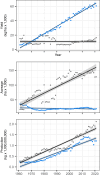Genetic gains underpinning a little-known strawberry Green Revolution
- PMID: 38504104
- PMCID: PMC10951273
- DOI: 10.1038/s41467-024-46421-6
Genetic gains underpinning a little-known strawberry Green Revolution
Abstract
The annual production of strawberry has increased by one million tonnes in the US and 8.4 million tonnes worldwide since 1960. Here we show that the US expansion was driven by genetic gains from Green Revolution breeding and production advances that increased yields by 2,755%. Using a California population with a century-long breeding history and phenotypes of hybrids observed in coastal California environments, we estimate that breeding has increased fruit yields by 2,974-6,636%, counts by 1,454-3,940%, weights by 228-504%, and firmness by 239-769%. Using genomic prediction approaches, we pinpoint the origin of the Green Revolution to the early 1950s and uncover significant increases in additive genetic variation caused by transgressive segregation and phenotypic diversification. Lastly, we show that the most consequential Green Revolution breeding breakthrough was the introduction of photoperiod-insensitive, PERPETUAL FLOWERING hybrids in the 1970s that doubled yields and drove the dramatic expansion of strawberry production in California.
© 2024. The Author(s).
Conflict of interest statement
The authors declare no competing interests.
Figures








Similar articles
-
Domestication of Temperate and Coastal Hybrids with Distinct Ancestral Gene Selection in Octoploid Strawberry.Plant Genome. 2018 Nov;11(3). doi: 10.3835/plantgenome2018.07.0049. Plant Genome. 2018. PMID: 30512037
-
Evidence of epistatic suppression of repeat fruiting in cultivated strawberry.BMC Plant Biol. 2019 Sep 5;19(1):386. doi: 10.1186/s12870-019-1984-7. BMC Plant Biol. 2019. PMID: 31488054 Free PMC article.
-
Accelerating genetic gains for quantitative resistance to verticillium wilt through predictive breeding in strawberry.Plant Genome. 2024 Mar;17(1):e20405. doi: 10.1002/tpg2.20405. Epub 2023 Nov 14. Plant Genome. 2024. PMID: 37961831
-
Molecular bases of strawberry fruit quality traits: Advances, challenges, and opportunities.Plant Physiol. 2023 Sep 22;193(2):900-914. doi: 10.1093/plphys/kiad376. Plant Physiol. 2023. PMID: 37399254 Review.
-
Genomic resources in plant breeding for sustainable agriculture.J Plant Physiol. 2021 Feb;257:153351. doi: 10.1016/j.jplph.2020.153351. Epub 2020 Dec 17. J Plant Physiol. 2021. PMID: 33412425 Free PMC article. Review.
Cited by
-
Why usefulness is rarely useful.G3 (Bethesda). 2025 Mar 18;15(3):jkae296. doi: 10.1093/g3journal/jkae296. G3 (Bethesda). 2025. PMID: 39719001 Free PMC article.
-
Loss-of-function mutations in the fruit softening gene POLYGALACTURONASE1 doubled fruit firmness in strawberry.Hortic Res. 2024 Nov 19;12(2):uhae315. doi: 10.1093/hr/uhae315. eCollection 2025 Feb. Hortic Res. 2024. PMID: 40371060 Free PMC article.
-
Exploration of a European-centered strawberry diversity panel provides markers and candidate genes for the control of fruit quality traits.Hortic Res. 2024 May 14;11(7):uhae137. doi: 10.1093/hr/uhae137. eCollection 2024 Jul. Hortic Res. 2024. PMID: 38988619 Free PMC article.
-
Within-family genomic selection in strawberry: Optimization of marker density, trial design, and training set composition.Plant Genome. 2025 Mar;18(1):e20550. doi: 10.1002/tpg2.20550. Plant Genome. 2025. PMID: 39789751 Free PMC article.
-
A Dominance Hypothesis Argument for Historical Genetic Gains and the Fixation of Heterosis in Octoploid Strawberry.Genetics. 2024 Oct 10;228(4):iyae159. doi: 10.1093/genetics/iyae159. Online ahead of print. Genetics. 2024. PMID: 39385702 Free PMC article.
References
-
- Darrow GM. The Strawberry: History, Breeding and Physiology. New York: Holt, Rinehart & Winston; 1966.
-
- Duchesne A-N. Histoire Naturelle Des Fraisiers. Paris: Didot le Jeune et C. J. Panckoucke; 1766.
-
- Hancock JF, Luby JJ. Genetic resources at our doorstep: the wild strawberries. BioScience. 1993;43:141–147. doi: 10.2307/1312017. - DOI

